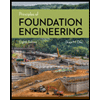In a standard penetration test in sands, the blow count measured at 14 m depth was 26. An automatic hammer released by a trip with an efficiency of 70% was used in the test. The unit weight of sand is 17.5 kN/m³. Determine: (a) N60 (N1)60 using Peck, Hanson, and Thornburn (1974) correlation with Pa = 100 kPa. The most likely value of the friction angle (not the range). The possible range of relative density per Peck et al. (1974) The Young's Modulus. The table below presents two correlations proposed for estimating Young's Modulus. kg Leonards (1986) = 8N60 E (kPa) = aPa (kPa)N60 Kulhawy & Mayne (1990)
In a standard penetration test in sands, the blow count measured at 14 m depth was 26. An automatic hammer released by a trip with an efficiency of 70% was used in the test. The unit weight of sand is 17.5 kN/m³. Determine: (a) N60 (N1)60 using Peck, Hanson, and Thornburn (1974) correlation with Pa = 100 kPa. The most likely value of the friction angle (not the range). The possible range of relative density per Peck et al. (1974) The Young's Modulus. The table below presents two correlations proposed for estimating Young's Modulus. kg Leonards (1986) = 8N60 E (kPa) = aPa (kPa)N60 Kulhawy & Mayne (1990)
Principles of Foundation Engineering (MindTap Course List)
8th Edition
ISBN:9781305081550
Author:Braja M. Das
Publisher:Braja M. Das
Chapter10: Drilled-shaft Foundations
Section: Chapter Questions
Problem 10.9P
Related questions
Question

Transcribed Image Text:In a standard penetration test in sands, the blow count measured at 14 m depth was 26. An
automatic hammer released by a trip with an efficiency of 70% was used in the test. The unit
weight of sand is 17.5 kN/m³. Determine:
(a)
N60
(N1) 60 using Peck, Hanson, and Thornburn (1974) correlation with Pa = 100 kPa.
The most likely value of the friction angle (not the range).
The possible range of relative density per Peck et al. (1974)
The Young's Modulus.
The table below presents two correlations proposed for estimating Young's Modulus.
kg
Leonards (1986)
E
.cm²
E (kPa):
= 8N60
=
aPa (kPa)N60 Kulhawy & Mayne (1990)
In the table a = 5 for fine sands, 10 for clean normally consolidated sands, and 15 for clean
over consolidated sands.
If a specific method is not specified, you may use any possible correlations. While doing so,
you must clearly indicate which correlation was used.
Expert Solution
This question has been solved!
Explore an expertly crafted, step-by-step solution for a thorough understanding of key concepts.
This is a popular solution!
Trending now
This is a popular solution!
Step by step
Solved in 5 steps with 12 images

Knowledge Booster
Learn more about
Need a deep-dive on the concept behind this application? Look no further. Learn more about this topic, civil-engineering and related others by exploring similar questions and additional content below.Recommended textbooks for you

Principles of Foundation Engineering (MindTap Cou…
Civil Engineering
ISBN:
9781305081550
Author:
Braja M. Das
Publisher:
Cengage Learning

Fundamentals of Geotechnical Engineering (MindTap…
Civil Engineering
ISBN:
9781305635180
Author:
Braja M. Das, Nagaratnam Sivakugan
Publisher:
Cengage Learning

Principles of Foundation Engineering (MindTap Cou…
Civil Engineering
ISBN:
9781337705028
Author:
Braja M. Das, Nagaratnam Sivakugan
Publisher:
Cengage Learning

Principles of Foundation Engineering (MindTap Cou…
Civil Engineering
ISBN:
9781305081550
Author:
Braja M. Das
Publisher:
Cengage Learning

Fundamentals of Geotechnical Engineering (MindTap…
Civil Engineering
ISBN:
9781305635180
Author:
Braja M. Das, Nagaratnam Sivakugan
Publisher:
Cengage Learning

Principles of Foundation Engineering (MindTap Cou…
Civil Engineering
ISBN:
9781337705028
Author:
Braja M. Das, Nagaratnam Sivakugan
Publisher:
Cengage Learning